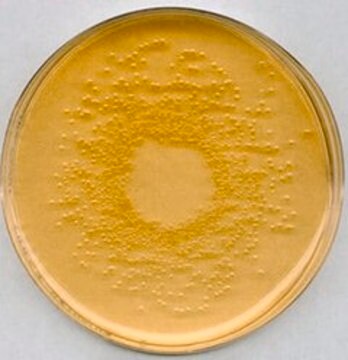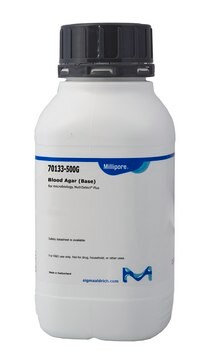Wszystkie zdjęcia(1)
Kluczowe dokumenty
15713
Uniwersalna membrana do identyfikacji patogenów żywności
light pink colored, sterile, diameter 70 mm, suitable for microbiology
Synonim(y):
Membrana wskaźnikowa, membrany ID
Zaloguj sięWyświetlanie cen organizacyjnych i kontraktowych
About This Item
Kod UNSPSC:
41171621
NACRES:
NA.85
Polecane produkty
membrane size
70 mm
sterylność
sterile
okres trwałości
limited shelf life, expiry date on the label
warunki przechowywania
protect from light
metody
microbe id | specific enzyme detection: suitable
Zastosowanie
food and beverages
microbiology
temp. przechowywania
2-8°C
przydatność
Bacillus spp.
Escherichia coli
Listeria spp.
Salmonella spp.
Shigella spp.
Staphylococcus spp.
coliforms
enterovirulent E. coli (EEC)
Opis ogólny
Uniwersalne membrany do identyfikacji patogenów żywności są membranami zawierającymi substraty stosowane do szybkiej identyfikacji i różnicowania patogenów żywności poprzez charakterystyczne reakcje barwne poprzez umieszczenie na powierzchni agaru po inkubacji. Membrany zawierają substraty chromogenne, takie jak ONPG, X-Gal lub X-Glu oraz inne substraty i wskaźniki, które służą jako podstawa do różnicowania drobnoustrojów na podstawie koloru. Organizmy docelowe posiadają systemy enzymatyczne, które metabolizują substraty w membranie, prowadząc do zmiany koloru. Kolory można wizualnie wykryć na membranie. Wskazuje to na aktywność enzymatyczną drobnoustrojów, która służy do identyfikacji rodzaju i gatunku. Ta ekonomiczna, potwierdzająca i szybka metoda identyfikacji jest odpowiednia dla mikroorganizmów z różnych produktów spożywczych, mlecznych, rybnych i mięsnych.
Zastosowanie
Uniwersalna membrana do identyfikacji patogenów żywnościowych jest zalecana do wykrywania patogenów żywnościowych, takich jak E. coli, E. coli O157:H7, Staphylococcus aureus, Salmonella, Bacillus, Listeria i Shigella itp. z różnych produktów spożywczych, mleczarskich, rybnych i mięsnych. Znajdują one zastosowanie w różnych sektorach, takich jak przemysł wodny, spożywczy i mleczarski.
Komentarz do analizy
Escherichia coli (25922) fioletowyStaphylococcus aureus (25923) złoto-żółtySalmonella Typhimurium (14028) bezbarwnyBacillus cereus (10876) jasnozielony (duży)Listeria monoyctogenes (19111) niebiesko-zielonyEscherichia coli O157:H7 (NCTC 12900) fioletowo-różowyShigella flexneri (12022) bezbarwny
Ta strona może zawierać tekst przetłumaczony maszynowo.
Kod klasy składowania
11 - Combustible Solids
Klasa zagrożenia wodnego (WGK)
WGK 3
Temperatura zapłonu (°F)
Not applicable
Temperatura zapłonu (°C)
Not applicable
Wybierz jedną z najnowszych wersji:
Masz już ten produkt?
Dokumenty związane z niedawno zakupionymi produktami zostały zamieszczone w Bibliotece dokumentów.
Peng Wang et al.
Current biology : CB, 27(21), 3278-3287 (2017-10-24)
The C
Johannes H Wilbertz et al.
Molecular cell, 73(5), 946-958 (2019-01-22)
Biological phase transitions form membrane-less organelles that generate distinct cellular environments. How molecules are partitioned between these compartments and the surrounding cellular space and the functional consequence of this localization is not well understood. Here, we report the localization of
Sofia Moreira et al.
Cell reports, 26(2), 293-301 (2019-01-10)
Apical-basal polarity is a common trait that underlies epithelial function. Although the asymmetric distribution of cortical polarity proteins works in a functioning equilibrium, it also retains plasticity to accommodate cell division, during which the basolateral determinant Lgl is released from
Lukas N Groschner et al.
Cell, 173(4), 894-905 (2018-05-01)
Perceptual decisions require the accumulation of sensory information to a response criterion. Most accounts of how the brain performs this process of temporal integration have focused on evolving patterns of spiking activity. We report that subthreshold changes in membrane voltage
Nasz zespół naukowców ma doświadczenie we wszystkich obszarach badań, w tym w naukach przyrodniczych, materiałoznawstwie, syntezie chemicznej, chromatografii, analityce i wielu innych dziedzinach.
Skontaktuj się z zespołem ds. pomocy technicznej







